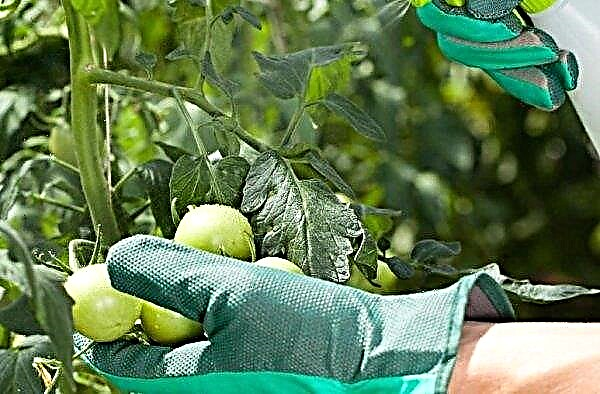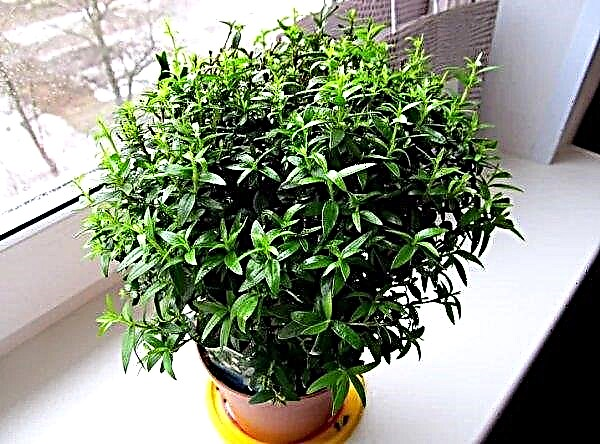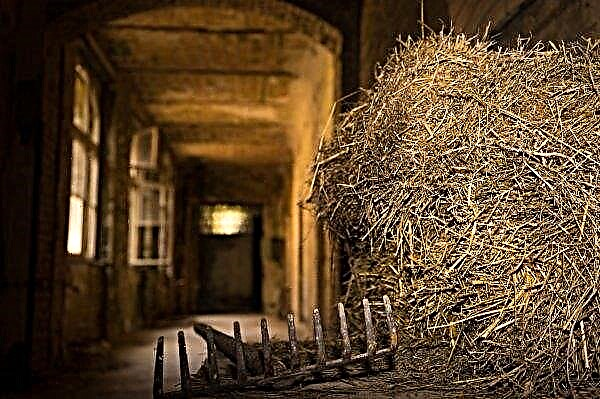Purple roses are the result of careful breeding work, which allowed to obtain flowers with petals of unique shades. Often you can find photos processed with special programs, but purple varieties of different saturation exist in reality. The characteristics of the most successful of them, as well as the basic rules of growing are presented below.
Description of the best varieties of purple roses
Petals of shades of purple, blue or black in nature do not occur, so all the plants presented are hybrids. Purple roses include plants with petals of various shades of purple, as well as close to purple. It is worth noting that the color also depends on the growing conditions, which is described in more detail in the corresponding section.
Did you know? Natural varieties of roses do not have the blue pigment dolphinidin. In 2004, the Japanese company Suntory used a genetic modification and was able to get a blue flower with a hint of lavender, which was called Applause.
According to expert and amateur reviews, the best varieties of purple roses are a few presented below.
Cardinal de Richeliau (Cardinal Richelieu)
Known since 1847 and refers to Gallic or French roses, however, it has an unusual set of chromosomes and can be a hybrid with a Chinese rose. Medium terry flowers have a rich purple color of "dark grapes."

Features of the flower and bush are as follows:
- flower size 5-6 cm, they are collected in small brushes;
- petals with a lighter underside and white spots at the base;
- the aroma is light, pepper;
- single flowering, lush, 4-5 weeks;
- bush height from 150 to 175 cm, width 150 cm;
- thin, drooping shoots with a minimum number of thorns;
- winter hardiness up to -30 ° С;
- susceptible to black spotting.
Claude Brasseur (Claude Brasser)
Refers to tea-hybrid roses. A variety of French selection from Meilland appeared in 2006. Large lavender flowers have earned high marks from connoisseurs.

Variety characteristics:
- flower size 13-14 cm;
- petals violet-purple, of different saturation, 75 pieces per flower;
- rich aroma, with notes of verbena and lemon;
- lush flowering, in two waves;
- bush 70–90 cm high, 50 cm wide;
- good winter hardiness;
- susceptibility to rust of roses is noted.
Night Owl (Night Oul / Night Owl)
Large-flowered klimber (climbing rose with thick shoots) of American selection from 2005. Semi-double flowers with yellow stamens appear on tall and stiff, erect stems characteristic of this type.
Other grade features:
- flower 9–11 cm in diameter, purple-violet, brightens toward the center;
- 3-5 flowers on one stalk;
- aroma of medium intensity, with notes of spices, cloves;
- flowering in two waves;
- bush height from 305 to 425 cm, strong, almost without thorns;
- frost resistant.
Midnight Blue (Midnight Blue / Midnight Blue)
A popular semi-climbing rose (scrub) from the USA, bred in 2004. The bush has light green foliage and flowers of dark purple hues.

Grade Features:
- flower with a diameter of 6–8 cm, moderately terry (17–25 petals);
- on one stem from 5 to 10 flowers with bright yellow stamens, ink shades, lighter in the middle;
- the aroma is strong, clove;
- flowering in two waves;
- bush 70–80 cm high, 60 cm wide;
- winters well, resistant to most diseases.
Rhapsody in Blue (Rhapsody in Blue / Rhapsody in Blue)
Scrub of English selection, dated 1999. According to experts, its color is one of the closest to blue.
Other indicators are as follows:
- flower 5-6 cm in diameter, semi-double;
- the color in the center is white, with yellow stamens, fades to pale lilac;
- flowers are collected in brushes, resistant to rain;
- the smell of medium saturation;
- bush height up to 120 cm, width 60 cm;
- It is resistant to powdery mildew and black spotting; it hibernates well.
Blue for You
Rose floribunda from the UK, bred in 2006. Lilac flowers of different shades on one bush immediately attract attention in the garden.
Grade Features:
- semi-double flowers, 7–9 cm in diameter, 3–5 pieces per stem;
- the petals to the center are white, the core with stamens open;
- strong aroma, citrus;
- flowering in two waves;
- bush up to 80 cm tall, 50 cm wide;
- winter hardiness is good.
Did you know? Rose oil is the main part of most perfume compositions. To obtain it, the flowers are plucked immediately after blooming before sunrise, when the content of essential substances is maximum.
The meaning of purple roses
The use of flowers to express feelings and desires has been known since Victorian times, and roses are a well-known symbol of love. Violet shades of roses have appeared recently, however, this color has always been considered "royal".
Modern floristry considers a purple rose a sign of sudden and strong love at first sight.
Optimal growing conditions
Growing roses requires attention and a careful approach from the gardener, but lush and long flowering justifies all costs. Most purple roses have no special differences in the placement and care of varieties of the same group (floribunda, scrub, climbing, etc.) with petals of other colors.
Location
Roses are preferred places with good lighting and medium blowing. To avoid "burnout" of color, it is better to plant purple varieties where there will be light partial shade in the afternoon.
A good defense against possible drafts can be a wall or a fence.
Basic soil requirements
The main soil requirement is good drainage and a sufficient amount of nutritious organic matter, which also retains moisture. Acidity should be in the range of 6-7 pH, close to neutral.
Important! You can not plant roses where other rosaceae grew: quince, hawthorn, cinquefoil, cherry, apricot, pear, or other roses over 10 years old. But if you want to plant them in exactly such a place, there is a way out: the earth in this section must be replaced by a depth of about half a meter.
Roses are extremely sensitive to flooded areas where their roots die from a lack of oxygen. In winter, this soil freezes harder.
How to plant purple roses
Roses are planted in the ground in spring or autumn. In spring, you need to wait until the soil has completely thawed and the temperature on it will be set at about + 10 ° C. In autumn, planting is carried out from mid-September to mid-October (depending on the region), so that the bush has taken root before the first frosts.
Pits must be prepared in advance, 2-3 weeks before planting. It is important to observe the optimal distance between the bushes so that crowding does not cause fungal diseases, and too rare placement does not lead to drying out of the soil and germination of weeds.
It is recommended to leave about 50 cm for floribunda and tea-hybrid varieties, for climbing ones, 1 m intervals are required, and for semi-climbing and park varieties it is better to leave about 1.5 m. For miniature plants, 25-30 cm will be enough.
Important! Weaving and shtambovyh varieties are laid and covered from frost, so you need to foresee a free place for shelter.
The depth of the pit should be 10-15 cm greater than the length of the root of the seedling. On heavy clay soil, this size is increased by another 20 cm. Before planting, it is necessary to inspect the seedlings, remove damaged roots and stems. For a day, it is desirable to put the plants in water.
On the day of planting, the roots are dipped in a clay mash of the following composition:
- 2 parts clay and 1 part fresh manure;
- 1 tablet of heteroauxin.

The mixture is diluted with water to the density of sour cream.
Then the bush is planted as follows (it is more convenient to work together):
- Pour part of the soil into the bottom of the pit.
- Lower the seedling and spread the roots on the hill. The place of vaccination (budding) should be 3-5 cm below the ground level, the roots should not bend up.
- Gradually sprinkle the bush with earth, compacting it with your hands and slightly trampling.
- Water the bush liberally and check the vaccination site again.
- To spud a sapling with earth on 20–25 cm and pritenit for 2 weeks.
Caring for Purple Roses
Care for the bushes should be regular, especially in the first year. An adult healthy bush will delight with lush flowering, if you follow the basic rules of cultivation.
Watering and fertilizing
For irrigation, it is advisable to use standing water, which is slightly heated in the sun. It is better to moisten the soil in the morning or evening, as the soil dries. During the hot season, some varieties may require daily watering. Water is poured under the root, protecting flowers and foliage from drops.
Rose bushes need nutrition throughout the growing season, every 2 weeks. Before flowering, nitrogen fertilizers are best suited, in the future you can use ready-made mixtures for roses, organic fertilizing (ash, manure, humus).
Fertilizer is stopped from the middle of summer to provide better frost resistance of the rose.
Pruning
The first pruning of the plant is carried out after wintering, when shoots and dead areas directed into the bush are removed. This process rejuvenates him, giving strength to the development of active young shoots.
Important! Each type of rose has its own pruning technology, which can be found in specialized literature.
Then, throughout the entire growth, it is necessary to cut off the faded buds and withered shoots. The slice is performed to an outwardly oriented shoot or dropping 1 bud below the flower. At the end of summer, wilted inflorescences are nipped at the base, so as not to stimulate the formation of young shoots before the cold. The last pruning is carried out before sheltering the bushes for the winter.
Pest and Disease Control
Different varieties are resistant to various diseases.
More common than others:
- rust, which is manifested by dark spots on the bottom of the leaf, drying out and falling of the leaves. For treatment, spraying with a solution of iron sulfate, prophylactic destruction of fallen leaves is used;

- spottingof which the most dangerous is black; It is treated by removing affected leaves, treatment with drugs or bio-solutions like Fitosporin-M. As a prophylaxis, spring pruning and spraying, complete removal of foliage before winter shelter are necessary;

- gray rot - starts with a flower and spreads down, forming yellow-brown spots that become wet and become covered with a fluffy coating.
 The causative agent is constantly present on the plant, but it affects only damaged places, therefore, rot can be resisted by careful prevention - you must avoid mechanical damage and not plant the bushes too thickly. Effective drugs "Fundazole", "Switch", "Fitodoctor", spraying with soap-soda solution or potassium permanganate solution.
The causative agent is constantly present on the plant, but it affects only damaged places, therefore, rot can be resisted by careful prevention - you must avoid mechanical damage and not plant the bushes too thickly. Effective drugs "Fundazole", "Switch", "Fitodoctor", spraying with soap-soda solution or potassium permanganate solution.
Among the pests, the most dangerous are:
Combination with other plants
Purple roses are a godsend for any garden. Shades of this color blend beautifully with most other colors. Be sure to consider the future dimensions of the bush, as well as the duration of flowering, in order to plan the decorative effect of a joint planting with flowering plants.
Roses go well with coniferous shrubs and junipers, which can become both a background and neighbors (depending on size). The classic combination with lavender and catnip in this case will require careful selection of varieties, since they also bloom in shades of purple and lilac.
One of the best partners is clematis with white flowers. This composition can be supplemented with plants with beautiful foliage - for example, geyhera and tiarellas.
Purple roses are the dream of many gardeners, and the work of breeders allows it to be carried out in any garden. Having picked up a suitable grade and precisely following the rules of cultivation, it is possible to achieve plentiful and long flowering.



 The causative agent is constantly present on the plant, but it affects only damaged places, therefore, rot can be resisted by careful prevention - you must avoid mechanical damage and not plant the bushes too thickly. Effective drugs "Fundazole", "Switch", "Fitodoctor", spraying with soap-soda solution or potassium permanganate solution.
The causative agent is constantly present on the plant, but it affects only damaged places, therefore, rot can be resisted by careful prevention - you must avoid mechanical damage and not plant the bushes too thickly. Effective drugs "Fundazole", "Switch", "Fitodoctor", spraying with soap-soda solution or potassium permanganate solution.










